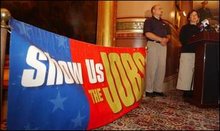Statement by AFL-CIO President John Sweeney
on Bush Administration Mortgage Rate Freeze Plan
After sitting idly by for months while countless Americans saw their dreams slip away, the Bush Administration has put forth a plan to deal with the subprime mortgage crisis that is both too little and too late.
The plan to freeze rates that was outlined this afternoon would cover only a small fraction of the mortgages at risk. But this is not the time to pick and choose who deserves help and who doesn't. We need a moratorium on subprime mortgage foreclosures for at least six to 12 months - enough time to restructure the loans in question.
Guaranteed, that will dam the flood of Americans losing their homes and their life savings. That's the kind of bold leadership we need. Otherwise, the wave of foreclosures is going to crush our economy because banks will not actually restructure enough loans to head off a crisis. A foreclosure moratorium will give banks no choice.
Next, the mortgage industry and government must create a structured program providing for the replacement of teaser rate loans with conventional 30 year mortgages at the teaser rate.
Servicers must renounce those servicing agreements that reward mortgage companies for foreclosing on homes rather than encourage refinancing or other workout strategies. And servicers must commit to publicly reporting -- company by company -- how many subprime loans they are servicing, how many have reset, how many have been restructured and how many foreclosures are occurring and where.
Finally, the federal government must reach out to subprime borrowers to let them know how they can keep their homes. The Treasury Department has encouraged this type of outreach by private groups, but this effort should be much more extensive and should be led by the government.
These are the steps necessary to stabilize our housing markets, prevent cascading defaults and safeguard our economy. The subprime crisis is not just a subprime crisis, and it is not just a housing crisis or a financial crisis. It threatens to become a full-blown economic crisis affecting both growth and employment. The roots of this crisis lie in the lack of effective regulation of the mortgage and other financial markets and on our economic policy makers' reliance on asset inflation to power economic growth in recent years. Falling or stagnant real wages, extreme inequality and the dominance of financial gimmickry over good jobs that create real value have left tens of millions of Americans dependent on borrowing to sustain their standard of living. Enacting these reforms are the first, critical step toward creating an economy that works for all Americans.
